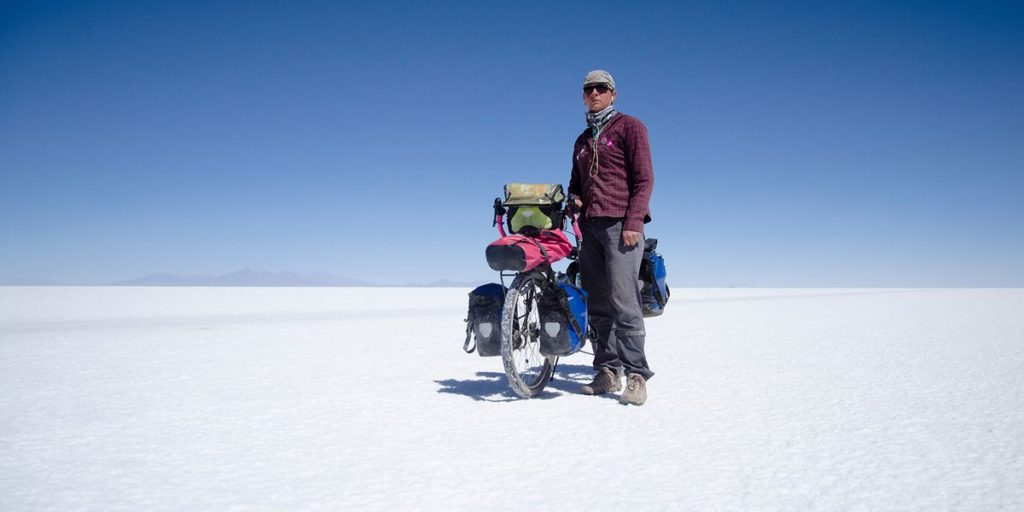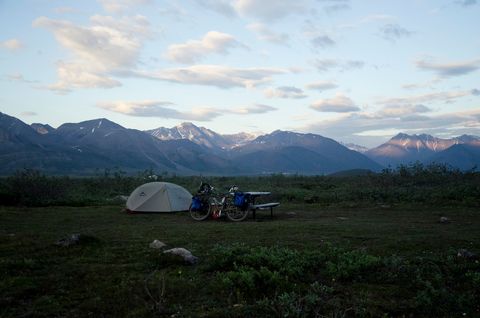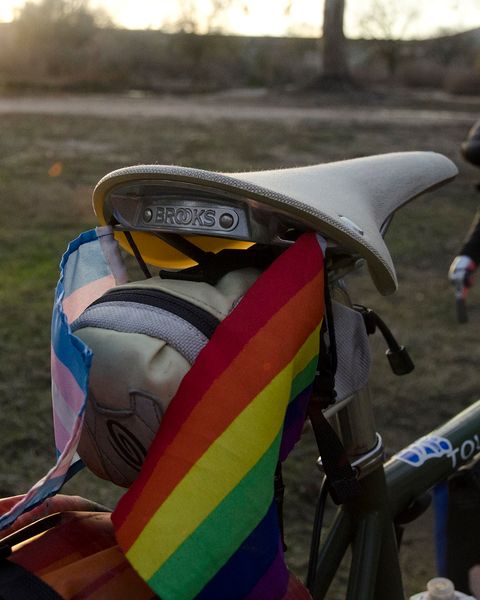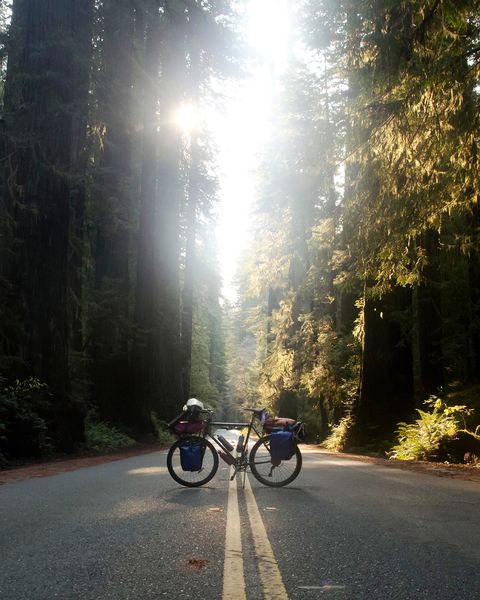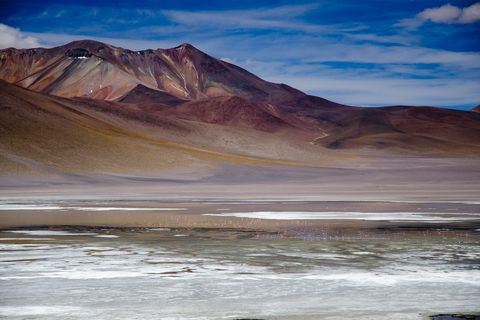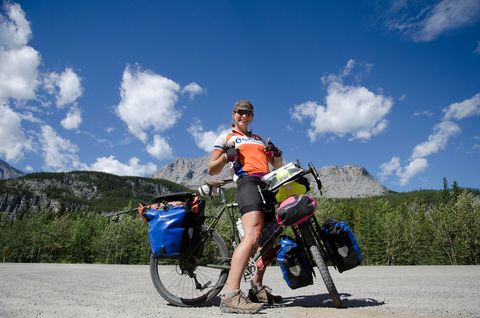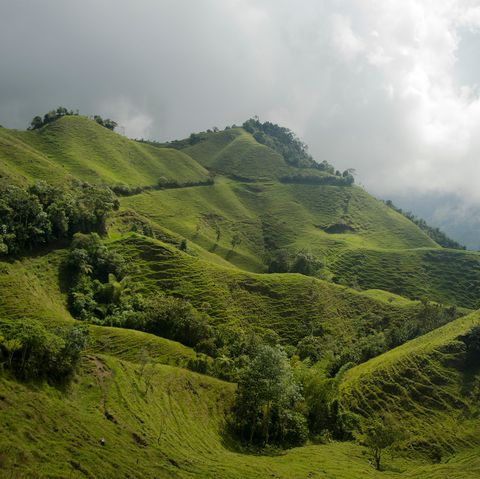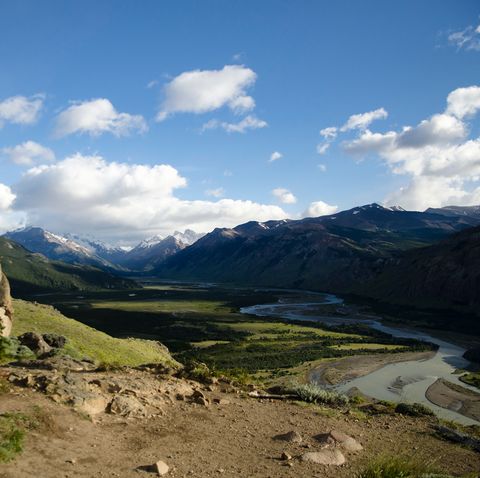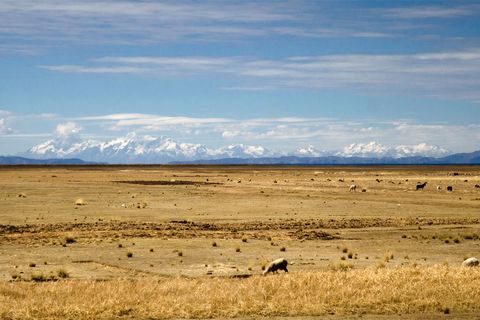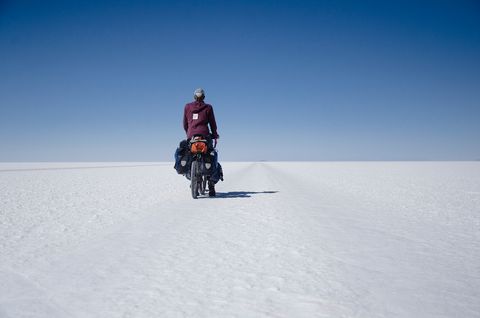Somewhere in the middle of Bolivia’s second largest salt flat, the Salar de Coipasa, my rear rack finally gave out. After 14,000 miles and 713 days of riding from Prudhoe Bay, Alaska, the aluminum apparatus that had held my pannier to my bike had snapped off and was resting uneasily on my cassette. If I couldn’t find a way to secure my rack, it would slowly grind away with every pedal rotation. It didn’t help that I was cycling through roughly 8 inches of very salty water.
Everything had been fine the evening before, when I sat in my camp chair sipping chamomile tea and gazing out over the vast salt flat I would cross the following day. White salt gleamed in all directions in the waning hours of daylight before the sun dipped below the Andes mountains, which surround the Salar de Coipasa like a crown. I was lost in thought about my situation and my life. How it had led me here, the choices I’d made that facilitated this moment, the freedom that allowed it. The freedom to just one day leave on a bike and head south for an indeterminate amount of time.
I grew up in Minnesota, and since I was a child I’ve found freedom on two wheels: from my first time pedaling my older brother’s two-wheeler unassisted down the sidewalk to my teenage years riding in the Saint Paul Classic Bike Tour. But as a transgender woman, I haven’t always felt free to be myself. For years I hid who I was, not only from the world around me but from myself. I feared that even admitting who I was would lead to coming out and being ostracized; that’s what all the articles I had read on the internet in the late ’90s and early aughts had told me. It was like being on probation: According to the outside world, I was free and living my life, but in reality I felt like I was on a short leash. Any slip-up could lead to accidentally outing myself and dealing with the repercussions.
Make Your Inbox More Awesome! 📬
I wish I could say that when I got to the point where I was ready to live true to myself, it was because I had reached new levels of self-confidence and self-assuredness. But in reality, by the time I hit my mid-20s, I had reached the end of my rope. I could no longer live the lie I had been selling the world and trying to sell to myself.
Early in my transition I was in a weird place. I’d given up on the identity I had created over 25 years and became someone new, someone with the memories of a past life but who didn’t quite understand how to fit into the world. I stopped sleeping and fell into a deep depression for months. At times it felt like the only way I would find peace would be to end my life. I was fortunate that I was able to get through this with the empathy of family and friendsand a local queer community that took me under its wing and let me explore who I am in a welcoming and safe space.
Few things in the world are as freeing as reaching a point of no return and coming out the other side. When you go through something profoundly traumatic and survive, most other troubles and worries seem trivial. So when it came to planning and preparing for my massive cycling adventure that landed me on the Bolivian altiplano—camping on an island in the middle of a giant salt flat—the fears and the worries that might have kept other people from attempting it barely registered in my mind.
I had done a big tour before, when I graduated university in 2012—a couple of thousand miles from central Minnesota to the Pacific Coast in Washington. I spent entire days in the saddle breathing the fresh air, and slept in a new place every night. When the ride was over, I stayed in the Twin Cities for a few years, focusing on my job in the climbing industry and leaning on my community of supportive family and friends while I continued to transition from living as male to female.
Many of my most supportive friends during that period were from Colombia. And by the time 2017 rolled around and my wanderlust returned, I had become obsessed with the idea of visiting the land that was home to so many people I was close with. That became the driving force behind my next big bike adventure: a north-to-south Pan-American Highway trip starting in Deadhorse, Alaska, through the Canadian Rockies, and south along the Pacific Coast. I’d then snake back and forth across Central America twice from the Pacific to the Caribbean before departing Panamá on a sailboat bound for Colombia.
The ride became a multiyear series of meandering detours, stops, and climbs with nothing more than the vague notion that I was heading eternally south. Sections of my trip took on their own tone. Alaska and Canada were marked by long days and short nights in the northern mountain ranges. By the time I reached the tropics I began riding earlier in the morning to avoid the dangerous afternoon temperatures. I watched the sun rise and set every day.
Reaching South America in October 2018 was a huge milestone. I had completed North America, only one continent to go. Colombia’s natural beauty and welcoming hospitality lived up to my expectations and more. As I climbed higher and higher into the Andes, I felt increasingly at home with the cooler temperatures. Left behind were the mornings when I’d rise in the predawn hours to ride before the tropical heat became too much. Now I spent my days pedaling up and down the sierras and my nights looking up from my campsite at the stars of the southern sky. When I had imagined my trip, it was this that I’d pictured.
After Colombia, I continued pedaling south through Ecuador, crossed into Peru along the coast, and then turned inland toward Bolivia. For me, the Bolivian altiplano was a dream come true. This high Andean plateau sits at roughly 3,800 meters and is a relatively flat area surrounded by giant mountains on all sides. Nights were often below freezing and the winds were strong. But I felt happy and free. That night on the Salar de Coipasa I watched the Milky Way climb slowly above the horizon until it seemed to envelop the whole sky. It was like being wrapped in the comfort of a mother’s hug. I fell asleep with a smile on my face, tucked into my sleeping bag counting alpacas as I drifted off.
The serenity of my previous night was still with me when I woke refreshed and confident that I was ready for what the day had in store. The Salar de Coipasa, unlike its larger and more famous sibling, the Salar de Uyuni just to the south, doesn’t get many tourists. I saw only one other vehicle that day. I felt alone and powerful atop my salted throne, with no humanity in sight and only the mountains visible. Another effect of this lack of traffic is the lack of a defined path across the salt. Instead of the smooth and well-worn paths that line the Salar de Uyuni, I faced a very bumpy and jarring ride. And that’s how I found myself sloshing through salty water with my rear rack banging against my cassette.
A crisis is only a crisis as long as you let it be one. I let this be a crisis for a minute or so, cursing the gods, the weather, the salt, everything I could think of while standing alone with a broken bike in the middle of a deserted salt flat. I indulged in self-pity for a moment, but then took a few deep breaths and reminded myself that I if had already overcome suicidal depression—the worst crisis of my life—I could absolutely handle this misadventure. I just had to woman up and devise a solution, since no one else could do it for me.
Unable to reattach the snapped rack to one of the bolt holes on my bike, I dug through my pack until I found some spare cord that I’d brought for emergencies. I strapped the rack to where the seat stay and chain stays meet. (It ended up being so stable that I considered not replacing the broken rack.) With that problem solved, I resumed my slow trek across the flat.
At the end of the day we are our biggest jailers, imprisoned in self-doubt, insecurities, and fear. Fear is one of our strongest motivators as animals; it keeps us alive and relatively safe from harm. But with that safety can come a paralyzing aversion to risk.
I don’t have all the answers for overcoming this stuff. I do know that there is a freedom that comes with letting go of your fear of the unknowns and the what-ifs and just being present in the here and now, focusing on what’s right in front of you. When you do that you might look up and see a way forward that you could have missed if you were only looking at the end goal.
The first step is realizing that there is a way, even if you might not know what it is at the moment. And that is where the journey begins.
